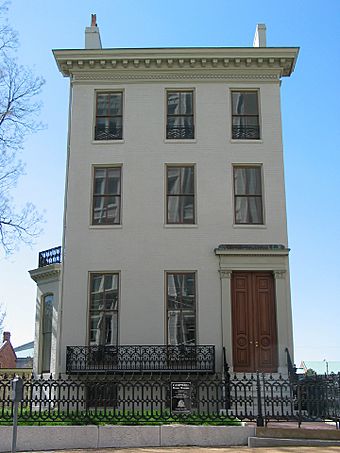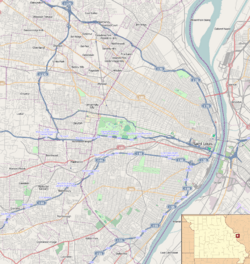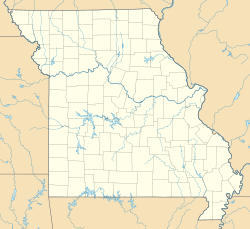Campbell House Museum facts for kids
Quick facts for kids |
|
|
Campbell House Museum
|
|
 |
|
| Location | 1508 Locust St., St. Louis, Missouri |
|---|---|
| Built | 1851 |
| Architectural style | Early Victorian, Greek Revival |
| NRHP reference No. | 77001560 |
| Added to NRHP | April 21, 1977 |
The Campbell House Museum is a special place in St. Louis, Missouri. It opened its doors on February 6, 1943. This museum helps us learn about the past. It shows what life was like for a wealthy family during the Victorian era. The house itself is very old. It was built in 1851. Over the years, it has been recognized as an important historical site. It became a City of St. Louis Landmark in 1946. Later, in 1977, it was added to the National Register of Historic Places. The Campbell House Foundation, a non-profit group, owns and runs the museum.
Contents
The Campbell Family Home
The Campbell House Museum tells the story of Robert Campbell and his wife, Virginia Kyle Campbell. Robert Campbell was an important person in St. Louis. He bought the house in 1853. The Campbell family lived there for many years. They stayed in the house until 1938. That's when their last child passed away. The house was originally on a street called Lucas Place. This street was new in the 1850s.
Changes to the House Over Time
When Robert Campbell bought the house, it cost about $18,000. Soon after moving in, he made some changes. He made the back of the house bigger. This added a larger kitchen and dining room. It also created more bedrooms for servants. In 1867, the family did more renovations. They combined two front rooms into one large space. They also added a three-story bay window. This window was on the east side of the house. Three extra rooms were added on the third floor.
In 1885, an outdoor porch was enclosed. This created a new room called the morning room. Around 1900, Lucas Place changed its name. It became known as Locust Street. The house address also changed. It became 1508 Locust Street, which is its address today.
How the Museum Began
Hazlett Campbell was the last surviving child of Robert Campbell. He died at home in 1938. After his death, it was unclear what would happen to the house. There were many legal discussions about the family's property. Experts in history and architecture visited the house. They were amazed by what they saw. They said the house had a unique collection of Victorian furnishings. It was clear that the house and its history needed to be saved.
Saving the Campbell House
A local history group stepped in to help. It was called the William Clark Society. They started a plan to save the house. They wanted to turn it into a museum. Important people joined the committee. These included historian Charles van Ravenswaay. The director of the St. Louis Art Museum, Perry Rathborne, also helped.
The Campbell family's cousins inherited the house's contents. They decided to sell everything at an auction. The auction happened in February 1941. The William Clark Society worked hard. They raised over $6,500 very quickly. With this money, they bought most of the furniture. Other people who bought items at the auction also donated them back. The Campbell House Foundation was officially created later that year.
In 1942, a local department store helped even more. Stix, Baer and Fuller bought the house. They then gave it to the people of St. Louis. They gave it through the Campbell House Foundation. The oldest Campbell son, Hugh, had left the house to Yale University in his will. He did this to honor his younger brother, James. James had attended Yale and passed away at age 30.
Early Years of the Museum (1943–1973)
Once the foundation owned the house, they started raising money. They wanted to fix up the inside. This included new wallpaper, paint, and carpets. This first redecoration was based on ideas from the mid-20th century. It wasn't an exact copy of how the house looked in the 1800s.
The Campbell House Museum officially opened on February 6, 1943. In the 1940s, it was one of the few museums. It focused on the history and art of the mid-Victorian period. The museum was featured in famous magazines. It appeared in Life in May 1945. It was also in National Geographic in March 1946.
The museum's rooms were redecorated again in 1967. In January 1973, the Campbell House was shown in Architectural Digest. Later that year, something very important happened. The museum received an album of 60 photographs. These photos were 8 by 10 inches. They showed the house's interior, room by room. They also showed the outside and the neighborhood. The photos were taken around 1885. They might have been taken by Hugh Campbell. This album was found in the trash of a law firm. This photo album is the most important item in the museum. It helped greatly with making the museum look like it did in the past.
Bringing the House Back to Life (1973–2005)
The discovery of the photo album was a game-changer. It allowed for accurate restoration of the rooms. The first room to be restored was the morning room. This work began in 1980. In the mid-1980s, the dining room was partly restored. Special painting techniques were used. They made wood look like wood grain. In the morning room, wallpaper was remade. It matched the pattern seen in the old photos. In the dining room, a fancy painted ceiling was recreated.
Major Restoration Project (2000–2005)
A big restoration project started in February 2000. First, all the museum's items were carefully packed away. The outside of the house was finished by mid-2001. This work included updating systems like heating. It also made the outside look like it did historically. Structural work was done to protect the building.
The inside restoration began in spring 2001. It was completed in 2005. The goal was to make the house look as close as possible to the 1885 photographs.
Museum Expansion (2019)
In 2019, the museum started a big expansion project. It cost $1.8 million. This project added a new entrance at street level. This new entrance is easy for everyone to use. It also includes two new education spaces. There is a new gift shop and a lobby. An elevator was added too. This elevator lets visitors tour the house without using stairs.




